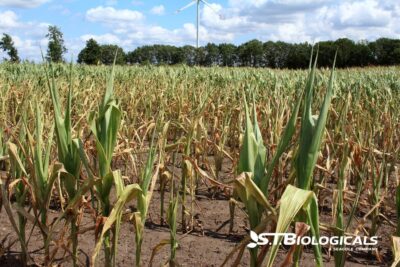Copper is a powerhouse micronutrient essential for enzyme activation, disease resistance, and strong reproductive growth. But here’s the catch: most soils don’t make copper readily available to plants, especially in high-organic or clay-heavy environments. That’s where chelated copper steps in, offering a highly plant-accessible, efficient, and balanced solution for modern farming.
Chelation: The Key to Maximum Uptake
Unlike traditional copper applications that risk binding with soil particles, chelated copper stays available for plant absorption. Chelation wraps copper in a protective organic molecule, preventing it from getting locked up by soil chemistry. The result? Consistent nutrient availability without waste.
Why Growers Should Consider Chelated Copper over Conventional Forms
- Higher Efficiency: Less nutrient loss to soil fixation, meaning more copper reaches plant roots.
- Better Soil & Microbial Balance: Chelated copper reduces toxicity risks while keeping microbial activity intact.
- Improved Disease Resistance: Supports fungal protection and reinforces plant immune systems.
- Flexible Application: Works infoliar sprays, fertigation systems, or soil applications, adapting to growers’ needs.
Strategic Applications for Maximum Benefit
- Early-Season Boost: Ideal for nutrient-deficient soils to kickstart plant metabolism.
- Foliar Sprays for Quick Correction: Chelates ensure rapid absorption, perfect for mid-season deficiencies.
- Integrated Soil Management: A great fit for balanced fertilization programs, optimizing copper alongside other key micronutrients.
By choosing chelated copper, you bypass common nutrient lock-up challenges while enhancing efficiency, yield potential, and overall plant health. The bottom line? Chelated copper is a smarter investment for soil and crop vitality.
But are all chelated copper-based growth amendments the same? No. The differences come down to chelate type, stability, sil interactions, and plant availability.
We’ve been using and recommending Attest-O for our organic clients for many years. It stands out from any other copper sources because of its higher efficiency, reduced environmental risks, and greater flexibility over diverse growing conditions.
Why Foliar Feeding Matters
When you’re practicing no-till, cover crop use, and few if any pesticide applications, you need healthy plants. A plant is set up for disease and pest issues when it has a nutrient deficiency. We’ve been taught to add nutrients such as nitrogen, phosphorus, and potassium at planting to decrease the number of times over the field. But is that the most effective use of your input budget?
Soil health, for an organic row crop grower, is a primary concern. And healthy soil is indeed necessary for healthy and productive crops. In the long haul, your goal is to improve soil health with amendments such as compost, manure, green manure (cover crops), and to disturb the soil as little as possible.
So why would you go to the extra effort to foliar feed your crop? It’s simple. The soil is a living system that binds nutrients whenever it has a deficiency, which in turn, creates a deficiency in your crop until the soil has reached a balance.
In the short term, foliar feeding gets the nutrient directly into your plants, and excess goes to the soil for balance. One of the primary advantages of foliar feeding is its ability to quickly address micronutrient deficiencies that can lead to stunted growth, poor fruit development, and reduced resistance to disease.
By delivering trace element mixtures directly to the foliage, plants can swiftly correct imbalances that may not be easily mitigated through soil amendments. Micronutrients are often required in minute quantities, yet their absence can significantly impact plant health. For instance, a deficiency in copper or zinc can lead to poor leaf development and delayed maturity, while insufficient iron can cause chlorosis, manifesting as a yellowing of the leaves. Foliar spraying addresses these issues efficiently, making it a vital practice for row crop farmers seeking to optimize plant health and productivity.
Which Micronutrients are Needed When for Optimal Crop Health?
At the start of your growing season, you apply nitrogen, phosphorus, and potassium (or they are supplied by your cover crops and those hard-working soil microbes). For many soils, deficiencies in micro nutrients are the limiting factors in farm profitability. Copper is one of those micronutrients that must be available to plants early in their growth. It helps activate enzymes that drive photosynthesis and other metabolic processes, ensuring robust plant growth right from the start.
Of course, a balance of micro nutrients is critical. But often, soils are not in balance, and the nutrients applied as soil amendments won’t make it into the plants. A soil test (and we can’t recommend regular soil testing enough) may show you have a balance of micronutrients, yet you’ll see copper deficiencies in your crops. This article from the University of Minnesota Extension explains what to look for with a copper deficiency. We recommend foliar feeding of a copper growth nutrient to offset those copper deficiencies and have optimum seed formation and grain production.
For all the micronutrients such as sulfur, magnesium, molybdenum, boron, manganese, zinc, and iron, we recommend foliar feeding and the use of a diverse cover crop. The cover crops will supply food to the beneficial microbes and help balance the soil nutrient profile in the long term, the foliar spray will take care of this year. But foliar spraying is not a silver bullet. The goal is to have soil that supplies the nutrients your crops need when and where they need them.
Organic or Conventional, Microbes Make Micronutrient Uptake Efficient
The role of soil microbes in an organic row crop agricultural operation can’t be overstated. Using no-till allows beneficial fungi to establish colonies that create resiliency in your fields. The pathways for micro nutrient absorption by a plant are the same whether you’re an organic, conventional, or regenerative row crop farmer. For an in-depth look at these pathways, go here. [link to blog 1a june 2025]
The benefit of organic cultivation is that you have microbes in the soil working for you – FOR FREE! Our regenerative agriculture experience has taught us that those microbes are foundational for the optimal growth and productivity of that seedling you’re staring at in your field.
Most agricultural soils are bacteria-dominant, but organic, no-till row crop farms have a better bacteria/fungi ratio. When you foliar feed any micronutrients, you have to be aware of the fine line between “essential” and “toxic” to those soil organisms. That’s why we recommend foliar spray of Attest-O as a microbially friendly source of necessary copper for plant growth. It also eliminates the need for soil compatibility adjustments while maximizing flavor, storage ability, and sugar content of fruit and grains.
To learn more about the importance of the right amount of copper on your farm, go to Copper: an Essential Micronutrient – ST Biologicals. We’re here to help you succeed. When soil speaks, we listen.

